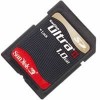SanDisk SDSDH-1024 Product Manual - Page 94
Multiple Block Write Operation
 |
UPC - 710348911073
View all SanDisk SDSDH-1024 manuals
Add to My Manuals
Save this manual to your list of manuals |
Page 94 highlights
Revision 2.2 Chapter 5 - SPI Protocol SD Card Product Manual Every data block has a prefix or 'start block' token (one byte). After a data block is received the card will respond with a data-response token, and if the data block is received with no errors, it will be programmed. As long as the card is busy programming, a continuous stream of busy tokens will be sent to the host (effectively holding the dataOut line low). Once the programming operation is completed, the host must check the results of the programming using the SEND_STATUS command (CMD13). Some errors (e.g., address out of range, write protect violation, etc.) are detected during programming only. The only validation check performed on the data block and communicated to the host via the dataresponse token is CRC and general Write Error indication. In multiple-block write operations, the stop transmission is done by sending, at the beginning of the next block, a Stop Tran token, instead of a Start Block token. In case of Write Error indication (on the data response) the host shall use SEND_NUM_WR_BLOCKS (ACMD22) in order to get the number of well written write blocks. The data token's description is given in Section 5.17. Figure 5-5 Multiple Block Write Operation From host to card Start block From card token to host Data from host to card Data response and busy from card DataIn Command Data Block Data Block Data from host to card Stop tran token DataOut Response Data_Response Busy Data_Response Busy Busy Resetting the CS signal while the card is busy does not terminate the programming process. The card releases the dataOut line (tristate) and continues to program. If the card is reselected before the programming has finished, the dataOut line will be forced back to low and all commands will be rejected. Re-setting a card (using CMD0) will terminate any pending or active programming operation. This may destroy the data formats on the card. It is the host's responsibility to prevent it. 5.6 Erase and Write Protect Management The erase and write protect management procedures in the SPI mode are identical to the SD Bus mode. While the card is erasing or changing the write protection bits of the predefined sector list it will be in a busy state and will hold the dataOut line low. Figure 5-6 illustrates a "no data" bus transaction with and without busy signaling. © 2004 SanDisk Corporation 5-4 12/08/04















